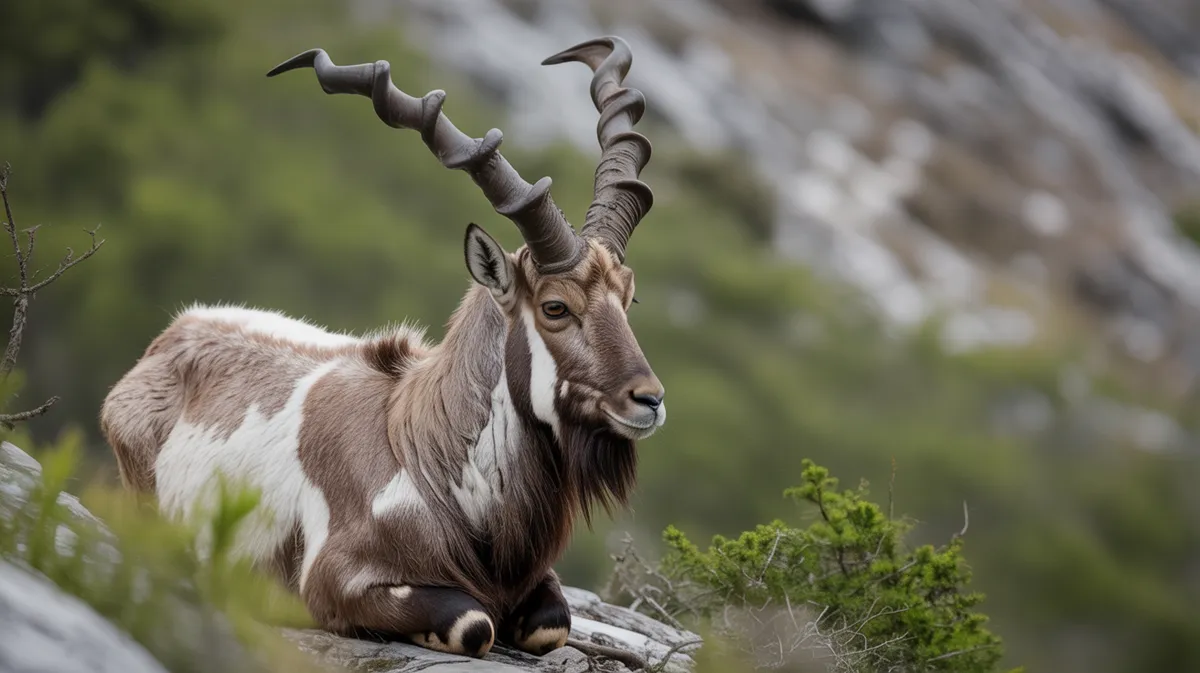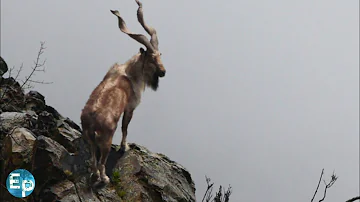
Markhor
Capra falconeri

Meet the Markhor
The Markhor is a large wild goat renowned for its striking, twisted horns, which can grow up to 1.6 meters long in males. Native to the rugged mountains of Central and South Asia, particularly in Pakistan, Afghanistan, India, and Tajikistan, it is well adapted to steep, rocky terrain. Markhors have a shaggy coat that varies in color from light brown to dark gray, providing camouflage in their mountainous habitats. They are social animals, often seen in small herds, and play a crucial role in their ecosystem as browsers, helping to maintain plant diversity.
Classification
Mammal
Habitat
Mountainous forest and scrublands
Diet
Herbivore
Lifespan
10-13 years
Conservation
Near Threatened
Weight
32–110 kg (70–240 lbs)
📖Fascinating Facts
Spectacular Horns
Male Markhor have impressive spiral horns that can reach up to 1.6 meters (5.2 feet) in length, making them one of the most striking wild goats.
Mountain Dwellers
Markhor inhabit elevations between 600 and 3,600 meters, expertly navigating rugged cliffs and rocky outcrops in search of food.
National Symbol
The Markhor is the national animal of Pakistan and features prominently in the country's cultural heritage and conservation efforts.
📋Detailed Description
The markhor (Capra falconeri) is a robust, large-bodied wild goat, with adult males weighing between 80–110 kg and standing up to 115 cm at the shoulder, while females are generally smaller and lighter. Markhors are instantly recognizable by their spectacular corkscrew-shaped horns, which can reach up to 1.6 meters in males and about 25 cm in females. Their pelage is long and shaggy, especially in winter, with coloration ranging from tan to dark brown or gray, often with a lighter underbelly and contrasting black and white markings on the legs and face. Males possess a pronounced ruff of longer hair on the throat and chest, which becomes more prominent during the breeding season. The species exhibits sexual dimorphism, with males being larger and more ornamented than females. Markhor have keen eyesight and agility, enabling them to navigate steep, rocky cliffs and escape predators. They are primarily crepuscular, being most active during early morning and late afternoon. Markhor play a vital ecological role as browsers, feeding on a variety of shrubs, grasses, and leaves, which helps maintain plant community dynamics in their mountainous habitats.
💡 Did you know?
Despite being called 'snake eaters,' Markhor are strict herbivores and do not consume snakes.
🔬Research & Sources
Wikipedia Summary
The markhor is a large wild Capra (goat) species native to South Asia and Central Asia, mainly within Pakistan, the Karakoram range, parts of Afghanistan, and the Himalayas. It is listed on the IUCN Red List as Near Threatened since 2015.
Last Modified: 5/17/2025
🎭Behavior & Social Structure
Markhor are generally social, forming small herds of 2–12 individuals, though larger aggregations may occur in areas with abundant resources. Herds are typically segregated by sex outside the breeding season, with females and young forming nursery groups, while males are more solitary or form bachelor groups. They are highly agile climbers, often seen scaling near-vertical cliffs to access food or evade predators such as leopards, wolves, and snow leopards. Markhor are primarily browsers, feeding on leaves, twigs, herbs, and grasses, and will stand on their hind legs to reach higher foliage. They exhibit seasonal altitudinal migrations, moving to lower elevations in winter to avoid deep snow. Markhor communicate through a range of vocalizations, body postures, and scent marking, particularly during the rut. Daily routines involve alternating periods of feeding, resting in shaded or sheltered spots, and vigilant scanning for predators.
👶Reproduction & Life Cycle
Markhor have a distinct breeding season (rut) from late autumn to early winter (November–January), during which males compete for access to females through displays and occasional horn clashes. Dominant males mate with receptive females, which exhibit estrus for a short period. After successful mating, females undergo a gestation period of approximately 135–170 days, typically giving birth to one or two kids (rarely three) between late spring and early summer (April–June). Newborns are precocial, able to stand and follow their mothers within hours. Females isolate themselves in rocky outcrops or dense vegetation to give birth, returning to the herd with their young after a few days. Maternal care is strong, with mothers nursing and protecting their kids for several months. Sexual maturity is reached at 2–3 years for females and 3–4 years for males.
🛡️Adaptations & Survival
Markhor are superbly adapted to rugged, mountainous terrain. Their broad, rubbery hooves provide excellent grip on rocky surfaces, while their powerful limbs allow for agile climbing and leaping. The twisted horns serve not only as weapons in male-male competition but may also aid in defense against predators. Their cryptic coloration and shaggy coat provide camouflage and insulation against harsh alpine climates. Markhor have a highly efficient digestive system, enabling them to extract nutrients from fibrous, low-quality browse. Behavioral adaptations include seasonal migrations and flexible social structures, allowing them to exploit patchy resources and avoid predation.
🎨Cultural Significance
The markhor holds significant cultural and symbolic value in its native range. It is the national animal of Pakistan and features prominently in folklore, art, and mythology, often symbolizing strength, resilience, and agility. The name 'markhor' is derived from Persian, meaning 'snake-eater,' stemming from the belief that the animal kills and consumes snakes, although this is not supported by scientific evidence. Markhor horns have been used in traditional medicine and as status symbols. Conservation programs have leveraged its cultural importance to foster local stewardship and sustainable management.
🔬Recent Research & Discoveries
Recent studies have focused on the genetic diversity and phylogeography of markhor populations, revealing distinct subspecies and highlighting the need for targeted conservation strategies. Camera trapping and satellite telemetry have improved understanding of their habitat use, movement patterns, and population dynamics. Community-based conservation initiatives, particularly in Pakistan and Tajikistan, have demonstrated that regulated trophy hunting can provide economic incentives for local communities and contribute to population recovery. Ongoing research addresses the impacts of climate change, disease transmission from livestock, and the effectiveness of protected area networks.
🎥Wildlife Videos

Markhor Documentary I Wildlife Documentary
Markhor is an incredible wild goat with male horns measuring almost 5 feet and weighing more than 100 kilos. The kids are born ...
Rewild with ABD

The magnificent markhor। Wildlife Pakistan। Full documentary
Markhor is an incredible wild goat with male horns measuring almost 5 feet and weighing more than 100 kilos. The kids are born ...
Earth Pic

The Magnificent Markhor - Wildlife Diaries of Pakistan
Embark on an unforgettable journey with the first episode of our groundbreaking documentary series, #WildlifeDiariesofPakistan!
WWF - Pakistan

Wildlife Documentary The Markhor | Animated Stories | Informative |Nature
Wildlife Documentary The Markhor | Animated Stories | Informative |Nature ...
Animals World.official

Markhor: Meet the Cool Mountain Goat! | Animal Documentaries | Howly Tales
Embark on a Mountain Goat Quest! Join us on an epic journey to meet the Markhor, a super cool mountain goat with GIANT, twisty ...
Howly Tales

Himalayan Lynx Filmed Hunting Markhor in Pakistan for First Time
We're very excited to share never before seen, intimate footage of the Himalayan lynx, captured on the steep rocky cliffs of Chitral ...
WWF - Pakistan
🌍Habitat Information
The Markhor typically inhabits Mountainous forest and scrublands environments. Markhors have adapted to their environments with specialized features and behaviors.
Primary Habitat:
Mountainous forest and scrublands
More detailed habitat information will be available soon.
🛡️Conservation Status
The Markhor is currently classified as Near Threatened. Conservation efforts are crucial for preserving this species for future generations.
Common Threats:
- 🏠Habitat loss and fragmentation
- 🌡️Climate change impacts
- 🎯Hunting and poaching
- 🏭Human-wildlife conflict
⚠️Threats & Conservation Challenges
Major threats to markhor populations include habitat loss and fragmentation due to human encroachment, overgrazing by livestock, competition for food, and poaching for meat, trophies, and traditional medicine. Political instability and armed conflict in parts of their range further hinder conservation efforts. Despite some localized population recoveries due to community-based trophy hunting programs and protected areas, the overall population remains fragmented and vulnerable. The IUCN estimates the global population at around 5,800–6,200 mature individuals, with some subspecies critically endangered. Disease transmission from domestic livestock and climate change-induced habitat shifts are emerging concerns.
🔬Scientific Classification
Scientific Name
Capra falconeri
Classification Hierarchy
🔍 About Taxonomic Classification
Taxonomic classification is a hierarchical system used by scientists to classify and organize living organisms based on shared characteristics and evolutionary relationships.
The system moves from broad categories (Kingdom) to increasingly specific ones, with each animal's scientific name typically consisting of its Genus and species.
📝Community Notes
Share your observations and insights about the Markhor with our community of wildlife enthusiasts.
Join Our Community
Sign in to share your observations and connect with fellow wildlife enthusiasts.
Sign In to ContributeNo community notes yet
Be the first to share your observations about the Markhor!
Explore Markhor
Select a tab above to learn more about this amazing animal.
📸Photo Gallery
No photos available for this animal yet.
🌟Discover More Wildlife
Continue your journey of discovery with more fascinating animals from our database
